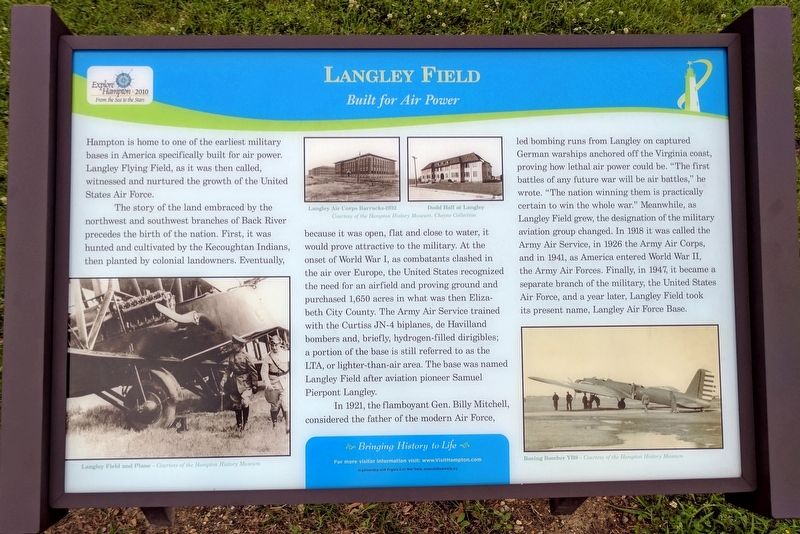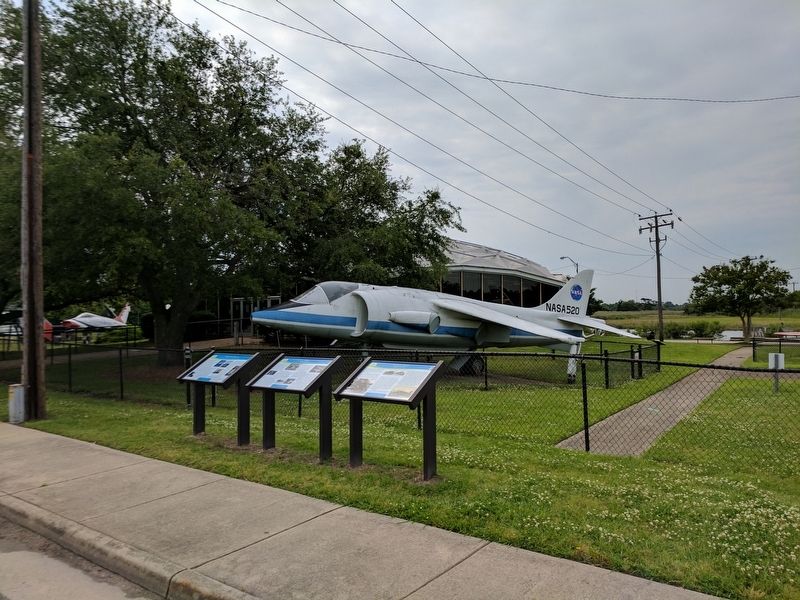Coliseum Central in Hampton, Virginia — The American South (Mid-Atlantic)
Langley Field
Built for Air Power
The story of the land embraced by the northwest and southwest branches of Back River precedes the birth of the nation. First, it was hunted and cultivated by the Kecoughtan Indians, then planted by colonial landowners. Eventually, because it was open, flat and close to water, it would prove attractive to the military. At the onset of World War 1, as combatants clashed in the air over Europe, the United States recognized the need for an airfield and proving ground and purchased 1,650 acres in what was then Elizabeth City County. The Army Air Service trained with the Curtiss JN-4 biplanes, de Havilland bombers and, briefly, hydrogen-filled dirigibles; a portion of the base is still referred to as the LTA, or lighter-than-air area. The base was named Langley Field after aviation pioneer Samuel Pierpont Langley.
In 1921, the flamboyant Gen. Billy Mitchell, considered the father of the modern Air Force, led bombing runs from Langley on captured German warships anchored off the Virginia coast, proving how lethal air power could be. “The first battles of any future war will be air battles,” he wrote. “The nation winning them is practically certain to win the whole war.” Meanwhile, as Langley Field grew, the designation of the military aviation group changed. In 1918 it was called the Army Air Service, in 1926 the Army Air Corps, and in 1941, as America entered World War II, the Army Air Forces. Finally, in 1947, it became a separate branch of the military, the United States Air Force, and a year later, Langley Field took its present name, Langley Air Force Base.
(captions)
Langley Field and Plane - Courtesy of the Hampton History Museum
Langley Air Corps Barracks-1932
Dodd Hall at Langley
Courtesy of the Hampton History Museum, Cheyne Collection
Boeing Bomber YB9 - Courtesy of the Hampton History Museum
Erected 2010 by Bring History to Life.
Topics. This historical marker is listed in these topic lists: Air & Space • War, World I • War, World II. A significant historical year for this entry is 1918.
Location. 37° 2.614′ N, 76° 21.994′ W. Marker is in Hampton, Virginia. It is in Coliseum Central. Marker is on West Mercury Boulevard (U.S. 258) west of LaSalle Avenue (Virginia Route 167), on the right when traveling east. Located in Air Power Park. Touch for map. Marker is at or near this postal address: 413 W Mercury Blvd, Hampton VA 23666, United States of America. Touch for directions.
Other nearby markers. At least 8 other markers are within walking distance of this marker. NACA (here, next to this marker); NASA Space History (here, next to this marker); A-7E Corsair II (a few steps from this marker); Mercury Test Capsule (within shouting distance of this marker); T-33A T-Bird (within shouting distance of this marker); M-2 Corporal (within shouting distance of this marker); A-2 Polaris (within shouting distance of this marker); Ajax (about 300 feet away, measured in a direct line). Touch for a list and map of all markers in Hampton.
Credits. This page was last revised on February 1, 2023. It was originally submitted on May 30, 2017, by Bernard Fisher of Richmond, Virginia. This page has been viewed 524 times since then and 66 times this year. Photos: 1, 2. submitted on May 30, 2017, by Bernard Fisher of Richmond, Virginia.

